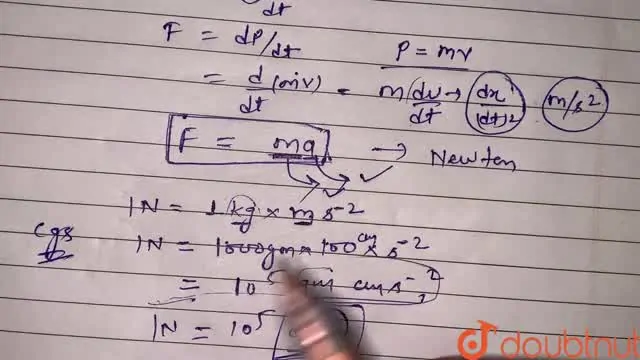State Newton’s second law of motion. How does it help to measure force? Also state the units of force.
Video Solution
Text Solution
Newton’s second law of motion states that the rate of change of momentum of a rigid body is directly proportional to the applied force on it. The law implies that when a bigger force is applied on a body of given mass, its linear momentum changes faster and vice-versa. The momentum will change in the direction of the applied force.
Let, mass of a body, →v = velocity of the body
∴ The linear momentum of the body→p=m→v......(i)
Now, suppose →F external force applied on the body in the direction of motion of the body.
Δ→p = a small change in linear momentum of the body in a small time Δt.
Rate of change of linear momentum of the body=Δ→pΔt. According to newton's second law law,
Δ→pΔtα.→f or →FαΔPΔt or →F=kΔ→pΔt
Where k is a constant of proportionality.
Taking the limit ΔT→0, then Δ→pΔt becomes the derivative or differential coefficient of →p w.r.t. time t.
It is denoted by d→pdt ∴ →F=kd→pdt Using e q n (i) →F=kddt(m→v)=km(d→vdt,
→F=km→a
where →a=d→vdt represent acceleration of the body.
The value of constant of proportionality k depends on the units adopted for measuring the force.
Now, putting k = 1
→F=m→a, this gives mean of measuring force. Units of force: force in SI units is measured in ‘Newton’ or N. from the relation →F=m→a, we can see that a Newton force is that force which produces 1ms−2 acceleration in a body of mass 1 kg.
1 newton = 1 kilogram × 1 metre /second2⇒1N=1kg×1ms−2=1kgms−2
In CGS system, force is measured in ‘dyne’ = 1 gram ×1ams−2=1gcms−2
since 1N=1kgms−2=1000g×100cms−2=10sgcms−2=105cms−2
⇒1N=105 dyne or 1 dyne =10−5N
|
Updated on:21/07/2023
Similar Questions
Newton's second law of motion is
View SolutionNewton's second law of motion is,
View SolutionState Newton's three law of motion.
View SolutionNewton's second law of motion gives us
View SolutionState and explain Newton's second law of motion.
View SolutionWhich law of motion gives the measure of force ?
View SolutionThe second law of motion states :
View SolutionState the Newton's second law of motion and deduce the Newton's first law from it.
View SolutionShow that Newton's second law of motion is the real law of motion.
View SolutionState the Newton's second law of motion and deduce the Newton's first law from it.
View Solution


